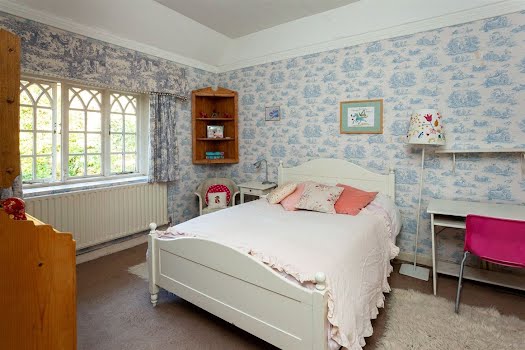
This 1700s Georgian Sporting Lodge in the foothills of the Dublin Mountains is on sale for €3.95 million
By IMAGE
20th Apr 2024
20th Apr 2024
The picturesque Glenasmole Lodge is a home of immense historical significance that has been featured in a number of renowned books, and you need to look around its interiors.
Early in the 1790s, George Grierson II chose this remarkable setting to build a Georgian Sporting Lodge in the foothills of the Dublin Mountains, close to the source of the River Dodder, which meanders through the lands.
Glenasmole Lodge is located just over 10 miles south of Dublin City Centre, and was completed in 1792 when it was known as Heathfield Lodge. It holds a commanding and picturesque position at the head of Glenasmole Valley. For a period between 1835 and 1947 the lodge was known as Cobbe Lodge when Charles Cobbe of Newbridge House, Donabate and his family enjoyed the property as a sporting lodge, thereafter the present name has been in use.

Advertisement
The general area of Glenasmole, which is a tranquil valley, has always been treasured by those fortunate enough to know it, this name can be interpreted in two ways; either as the Valley of the Thrushes (Glen na Smolach) or as the Valley of the Smouldering Embers (Glen a’Smol).
When approaching the lodge along a winding gravelled drive it is difficult not to be struck by the beauty and west of Ireland-type magic of the house and its immediate environs, a view that is immediately reinforced on arrival at the house. Grounds comprising some 34.3 acres surround the house and complement the wider acreage of picturesque mountainous lands that extend to in excess of 220 acres.

These lands blend naturally into the wider mountain landscape of commonage lands where pleasure walks and bridle paths can be enjoyed. The pleasure grounds within the estate are well-timbered and include superb specimens of Scots pine, beech, mountain ash and rhododendrons. The sloping nature of the grounds allows distant views out over the garden onto the heather-clad mountains and over the distant waters of Glenasmole Reservoir.
Glenasmole Lodge is a home of immense historical significance that has been featured in a number of renowned books including The Neighbourhood of Dublin by Weston St. John Joyce and In an Irish House edited by Sybil Connolly. In the early 1800s, the original house was destroyed by fire, with nothing but the stonework remaining. The compensation George Grierson received enabled him to rebuild the house in 1812.

Advertisement
The front of the house, facing Glenasmole Valley, was improved during this time by the addition of a long and wide ornamental veranda constructed using antique cast-iron columns purchased at Crowthers in London, a firm famous for the quality of its salvaged architectural ornaments. The decorative finials on top of the veranda come originally from the front of a chemist’s shop on Westmoreland Street.
On the south front, an eighteenth-century doorway from a house demolished in St. Stephen’s Green acts as a garden door. It is complete with its fanlight and incorporates an unusual lantern. Inside, there is a great character to the lodge and a homeliness that belies its size. It boasts the most wonderful vistas from almost every window, either of the glorious gardens, the valley below or of the picturesque mountain behind.

A Gothic-style panelled door leads into an entrance porch with ornate cornicing, parquet flooring and acanthus leaf moulding on the architraves that, in turn, lead into a stair hall, with pine timber carved staircase to the first floor and mezzanine floor. Formal reception rooms include a drawing room with a fine marble chimneypiece and a dual aspect with matching bow windows, a study again has a bow window along with double French doors opening to a garden terrace.
The library has a superb and large marble chimneypiece, part panelled walls, bookcases with finely carved columns, an ornate Diocletian window and a door to the veranda. The dining room has a carved pine chimneypiece, and an ornate arch with carved pine pediment. A French door with panelled and moulded architrave with an acanthus leaf motif leads from the dining room into the sunroom with its Gothic-style windows and double French doors to the garden.

Advertisement
On the first floor, a vestibule leads to the master bedroom suite with bedroom, bathroom and dressing room and is complimented by a guest bedroom suite, again with bedroom bathroom and dressing room. There are three further bedroom suites, making five in total. A secondary library staircase provides alternative access to the first floor.
However, a number of formal areas contrast with this general natural layout. A large paved terrace faces south, here two garden tables in early-cast concrete are exceptional. The kidney-shaped swimming pool and its pool house in Neo-Regency style have their own discreet setting. The tennis court is screened by a small arboretum of rare trees, many of them imported from the famous English nursery firm of Hillier’s. A cutting garden of hybrid tea and floribunda roses flanks the farmyard.

An old staff cottage with a belfry is now used as a dry storage area or garage. A short distance again beyond this farmstead there is a sand arena that must enjoy a setting equal, if not better, than any other and must make the equestrian activities all the more enjoyable. The lands immediately surrounding the house provide some useful grazing and link to the remaining lands, which are largely of mountain quality and amenity value.

On the market for €3,950,000 via Sherry FitzGerald Country Homes, Farms & Estates, take a full tour of Glenasmole Lodge through the gallery below…
Advertisement














































